SOC 450 Essay: Analyzing Crime Victims, Justice, and Homicide Grief
VerifiedAdded on 2023/06/10
|11
|3120
|489
Homework Assignment
AI Summary
This assignment delves into various aspects of crime and its impact on victims, examining both economic and non-economic costs associated with victimization. It explores the concept of 'twice victimized' individuals within the criminal justice system and discusses the role of cost-benefit analysis in addressing their needs. Furthermore, the assignment analyzes social categories related to homicide victimization, including gender, ethnicity, and age, and outlines the appropriate steps and considerations for delivering death notifications to grieving families. It also details the stages of grieving experienced by homicide survivors, common grief patterns, and the characteristics of mass-marketing fraud, including various types of fraud schemes highlighted by the Department of Justice. This document is available on Desklib, a platform offering a wide range of study tools and solved assignments for students.
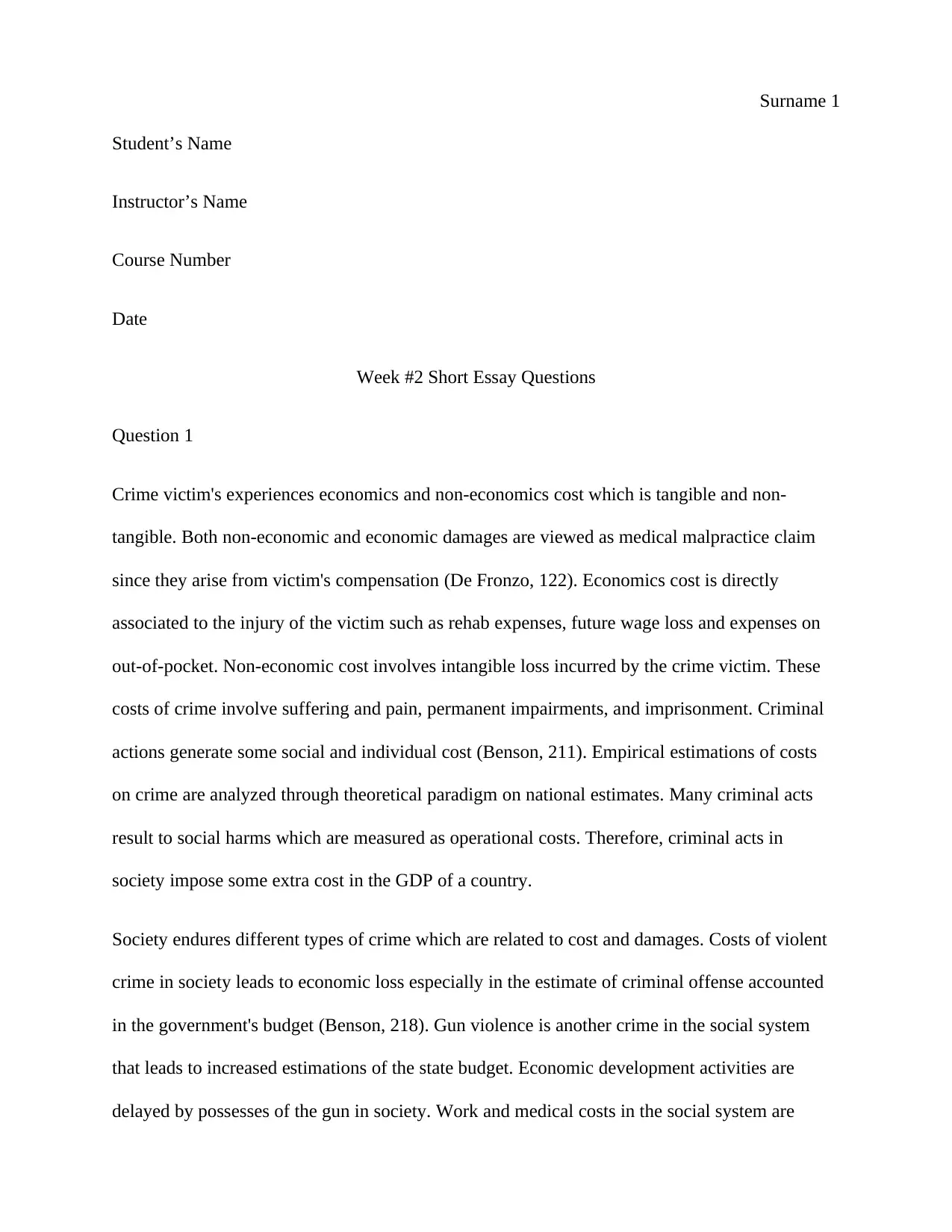
Surname 1
Student’s Name
Instructor’s Name
Course Number
Date
Week #2 Short Essay Questions
Question 1
Crime victim's experiences economics and non-economics cost which is tangible and non-
tangible. Both non-economic and economic damages are viewed as medical malpractice claim
since they arise from victim's compensation (De Fronzo, 122). Economics cost is directly
associated to the injury of the victim such as rehab expenses, future wage loss and expenses on
out-of-pocket. Non-economic cost involves intangible loss incurred by the crime victim. These
costs of crime involve suffering and pain, permanent impairments, and imprisonment. Criminal
actions generate some social and individual cost (Benson, 211). Empirical estimations of costs
on crime are analyzed through theoretical paradigm on national estimates. Many criminal acts
result to social harms which are measured as operational costs. Therefore, criminal acts in
society impose some extra cost in the GDP of a country.
Society endures different types of crime which are related to cost and damages. Costs of violent
crime in society leads to economic loss especially in the estimate of criminal offense accounted
in the government's budget (Benson, 218). Gun violence is another crime in the social system
that leads to increased estimations of the state budget. Economic development activities are
delayed by possesses of the gun in society. Work and medical costs in the social system are
Student’s Name
Instructor’s Name
Course Number
Date
Week #2 Short Essay Questions
Question 1
Crime victim's experiences economics and non-economics cost which is tangible and non-
tangible. Both non-economic and economic damages are viewed as medical malpractice claim
since they arise from victim's compensation (De Fronzo, 122). Economics cost is directly
associated to the injury of the victim such as rehab expenses, future wage loss and expenses on
out-of-pocket. Non-economic cost involves intangible loss incurred by the crime victim. These
costs of crime involve suffering and pain, permanent impairments, and imprisonment. Criminal
actions generate some social and individual cost (Benson, 211). Empirical estimations of costs
on crime are analyzed through theoretical paradigm on national estimates. Many criminal acts
result to social harms which are measured as operational costs. Therefore, criminal acts in
society impose some extra cost in the GDP of a country.
Society endures different types of crime which are related to cost and damages. Costs of violent
crime in society leads to economic loss especially in the estimate of criminal offense accounted
in the government's budget (Benson, 218). Gun violence is another crime in the social system
that leads to increased estimations of the state budget. Economic development activities are
delayed by possesses of the gun in society. Work and medical costs in the social system are
Paraphrase This Document
Need a fresh take? Get an instant paraphrase of this document with our AI Paraphraser
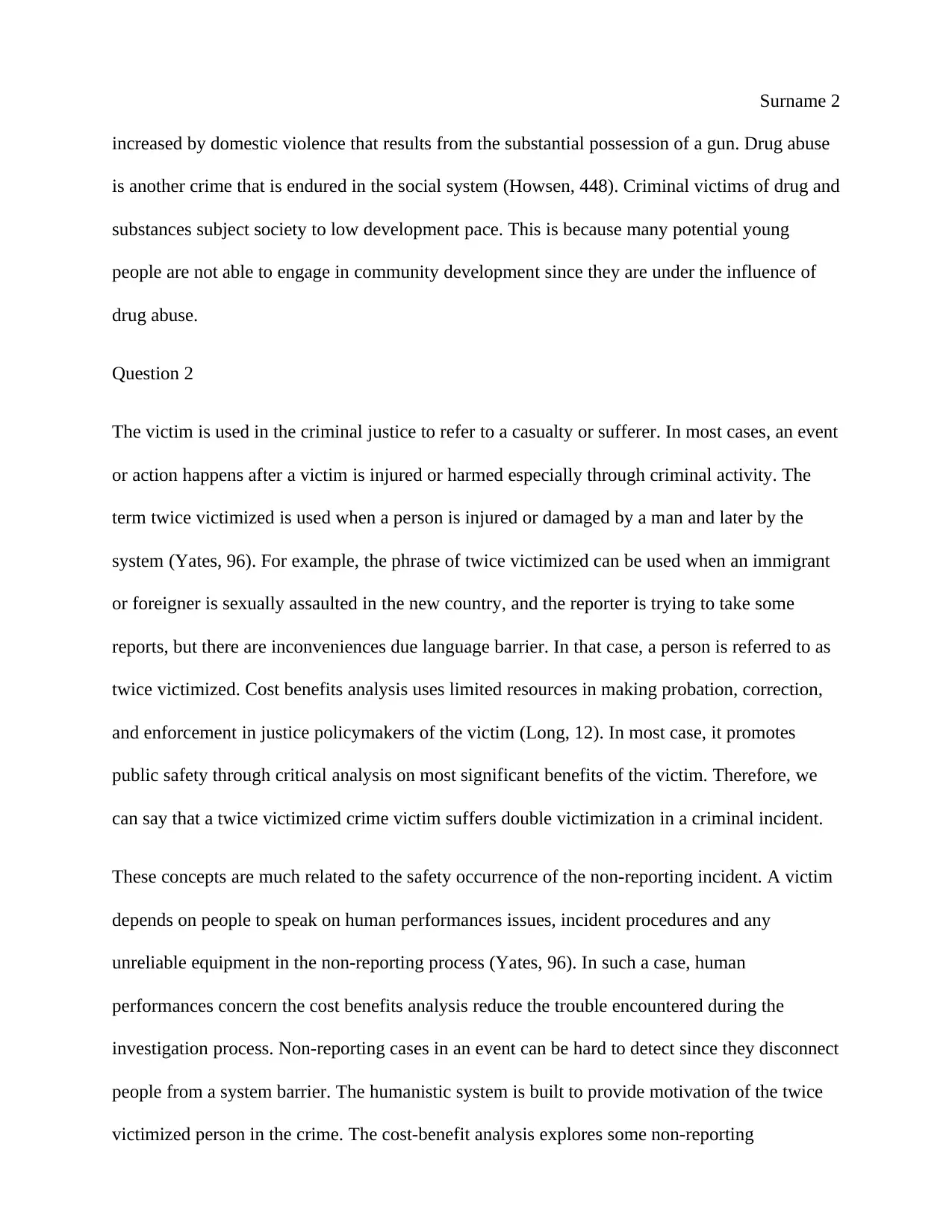
Surname 2
increased by domestic violence that results from the substantial possession of a gun. Drug abuse
is another crime that is endured in the social system (Howsen, 448). Criminal victims of drug and
substances subject society to low development pace. This is because many potential young
people are not able to engage in community development since they are under the influence of
drug abuse.
Question 2
The victim is used in the criminal justice to refer to a casualty or sufferer. In most cases, an event
or action happens after a victim is injured or harmed especially through criminal activity. The
term twice victimized is used when a person is injured or damaged by a man and later by the
system (Yates, 96). For example, the phrase of twice victimized can be used when an immigrant
or foreigner is sexually assaulted in the new country, and the reporter is trying to take some
reports, but there are inconveniences due language barrier. In that case, a person is referred to as
twice victimized. Cost benefits analysis uses limited resources in making probation, correction,
and enforcement in justice policymakers of the victim (Long, 12). In most case, it promotes
public safety through critical analysis on most significant benefits of the victim. Therefore, we
can say that a twice victimized crime victim suffers double victimization in a criminal incident.
These concepts are much related to the safety occurrence of the non-reporting incident. A victim
depends on people to speak on human performances issues, incident procedures and any
unreliable equipment in the non-reporting process (Yates, 96). In such a case, human
performances concern the cost benefits analysis reduce the trouble encountered during the
investigation process. Non-reporting cases in an event can be hard to detect since they disconnect
people from a system barrier. The humanistic system is built to provide motivation of the twice
victimized person in the crime. The cost-benefit analysis explores some non-reporting
increased by domestic violence that results from the substantial possession of a gun. Drug abuse
is another crime that is endured in the social system (Howsen, 448). Criminal victims of drug and
substances subject society to low development pace. This is because many potential young
people are not able to engage in community development since they are under the influence of
drug abuse.
Question 2
The victim is used in the criminal justice to refer to a casualty or sufferer. In most cases, an event
or action happens after a victim is injured or harmed especially through criminal activity. The
term twice victimized is used when a person is injured or damaged by a man and later by the
system (Yates, 96). For example, the phrase of twice victimized can be used when an immigrant
or foreigner is sexually assaulted in the new country, and the reporter is trying to take some
reports, but there are inconveniences due language barrier. In that case, a person is referred to as
twice victimized. Cost benefits analysis uses limited resources in making probation, correction,
and enforcement in justice policymakers of the victim (Long, 12). In most case, it promotes
public safety through critical analysis on most significant benefits of the victim. Therefore, we
can say that a twice victimized crime victim suffers double victimization in a criminal incident.
These concepts are much related to the safety occurrence of the non-reporting incident. A victim
depends on people to speak on human performances issues, incident procedures and any
unreliable equipment in the non-reporting process (Yates, 96). In such a case, human
performances concern the cost benefits analysis reduce the trouble encountered during the
investigation process. Non-reporting cases in an event can be hard to detect since they disconnect
people from a system barrier. The humanistic system is built to provide motivation of the twice
victimized person in the crime. The cost-benefit analysis explores some non-reporting
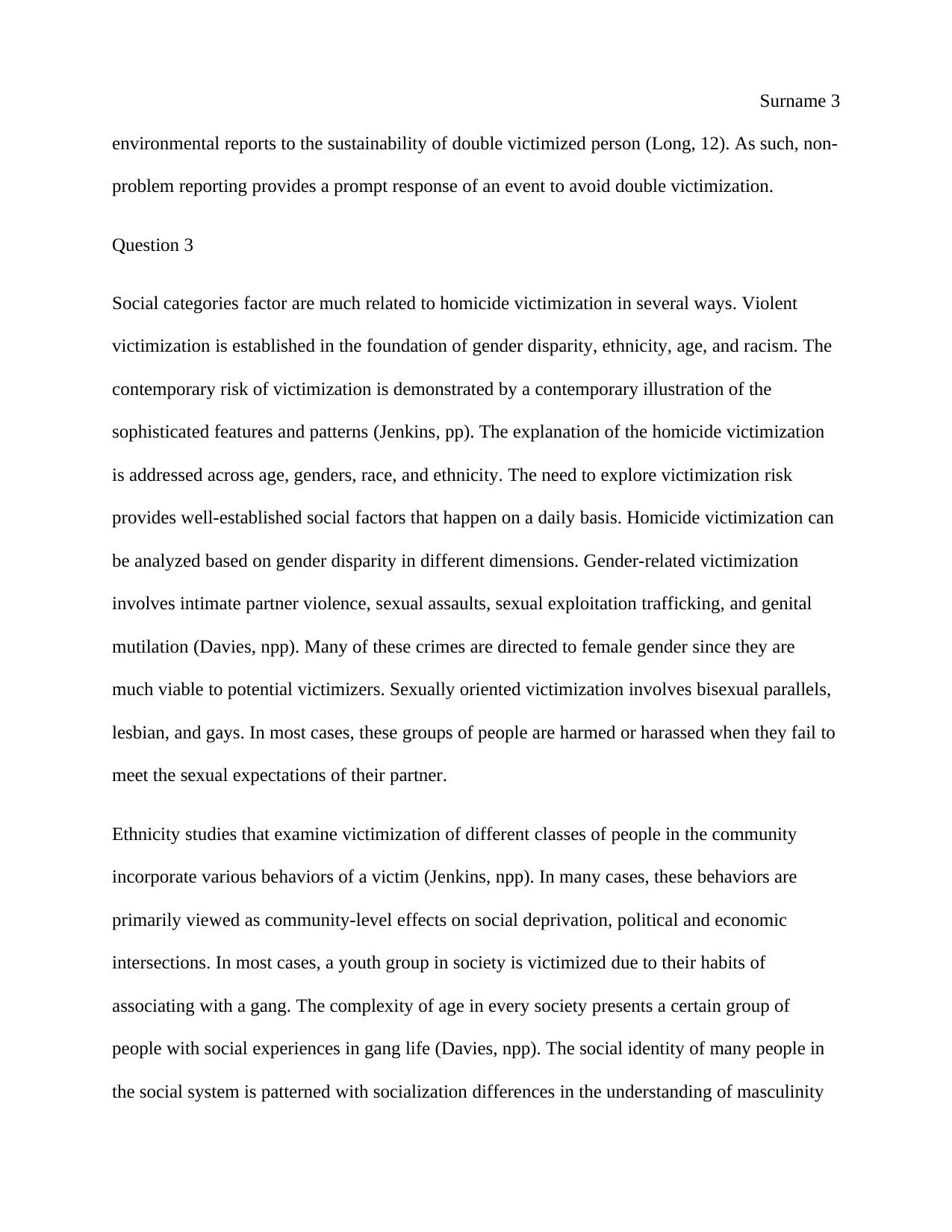
Surname 3
environmental reports to the sustainability of double victimized person (Long, 12). As such, non-
problem reporting provides a prompt response of an event to avoid double victimization.
Question 3
Social categories factor are much related to homicide victimization in several ways. Violent
victimization is established in the foundation of gender disparity, ethnicity, age, and racism. The
contemporary risk of victimization is demonstrated by a contemporary illustration of the
sophisticated features and patterns (Jenkins, pp). The explanation of the homicide victimization
is addressed across age, genders, race, and ethnicity. The need to explore victimization risk
provides well-established social factors that happen on a daily basis. Homicide victimization can
be analyzed based on gender disparity in different dimensions. Gender-related victimization
involves intimate partner violence, sexual assaults, sexual exploitation trafficking, and genital
mutilation (Davies, npp). Many of these crimes are directed to female gender since they are
much viable to potential victimizers. Sexually oriented victimization involves bisexual parallels,
lesbian, and gays. In most cases, these groups of people are harmed or harassed when they fail to
meet the sexual expectations of their partner.
Ethnicity studies that examine victimization of different classes of people in the community
incorporate various behaviors of a victim (Jenkins, npp). In many cases, these behaviors are
primarily viewed as community-level effects on social deprivation, political and economic
intersections. In most cases, a youth group in society is victimized due to their habits of
associating with a gang. The complexity of age in every society presents a certain group of
people with social experiences in gang life (Davies, npp). The social identity of many people in
the social system is patterned with socialization differences in the understanding of masculinity
environmental reports to the sustainability of double victimized person (Long, 12). As such, non-
problem reporting provides a prompt response of an event to avoid double victimization.
Question 3
Social categories factor are much related to homicide victimization in several ways. Violent
victimization is established in the foundation of gender disparity, ethnicity, age, and racism. The
contemporary risk of victimization is demonstrated by a contemporary illustration of the
sophisticated features and patterns (Jenkins, pp). The explanation of the homicide victimization
is addressed across age, genders, race, and ethnicity. The need to explore victimization risk
provides well-established social factors that happen on a daily basis. Homicide victimization can
be analyzed based on gender disparity in different dimensions. Gender-related victimization
involves intimate partner violence, sexual assaults, sexual exploitation trafficking, and genital
mutilation (Davies, npp). Many of these crimes are directed to female gender since they are
much viable to potential victimizers. Sexually oriented victimization involves bisexual parallels,
lesbian, and gays. In most cases, these groups of people are harmed or harassed when they fail to
meet the sexual expectations of their partner.
Ethnicity studies that examine victimization of different classes of people in the community
incorporate various behaviors of a victim (Jenkins, npp). In many cases, these behaviors are
primarily viewed as community-level effects on social deprivation, political and economic
intersections. In most cases, a youth group in society is victimized due to their habits of
associating with a gang. The complexity of age in every society presents a certain group of
people with social experiences in gang life (Davies, npp). The social identity of many people in
the social system is patterned with socialization differences in the understanding of masculinity
⊘ This is a preview!⊘
Do you want full access?
Subscribe today to unlock all pages.

Trusted by 1+ million students worldwide
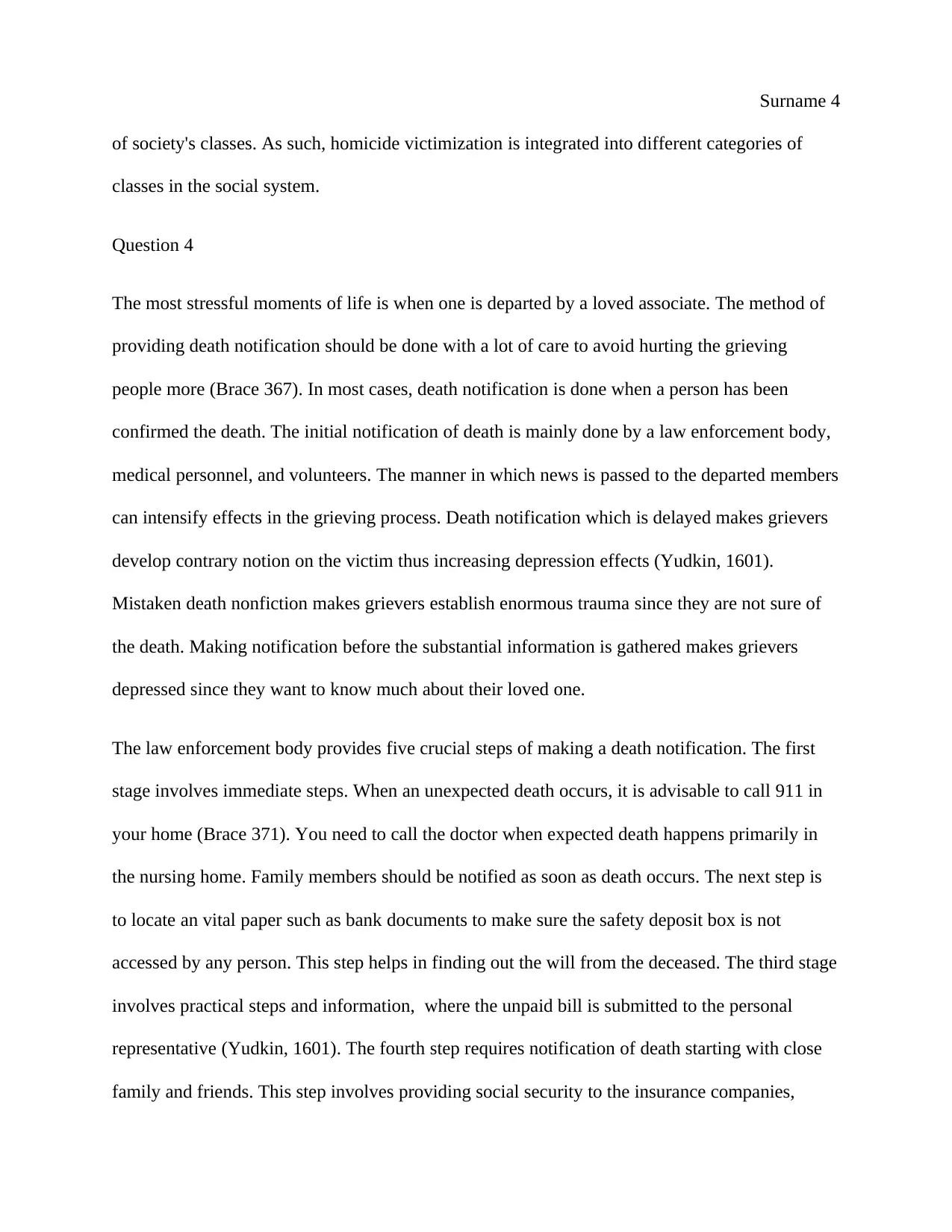
Surname 4
of society's classes. As such, homicide victimization is integrated into different categories of
classes in the social system.
Question 4
The most stressful moments of life is when one is departed by a loved associate. The method of
providing death notification should be done with a lot of care to avoid hurting the grieving
people more (Brace 367). In most cases, death notification is done when a person has been
confirmed the death. The initial notification of death is mainly done by a law enforcement body,
medical personnel, and volunteers. The manner in which news is passed to the departed members
can intensify effects in the grieving process. Death notification which is delayed makes grievers
develop contrary notion on the victim thus increasing depression effects (Yudkin, 1601).
Mistaken death nonfiction makes grievers establish enormous trauma since they are not sure of
the death. Making notification before the substantial information is gathered makes grievers
depressed since they want to know much about their loved one.
The law enforcement body provides five crucial steps of making a death notification. The first
stage involves immediate steps. When an unexpected death occurs, it is advisable to call 911 in
your home (Brace 371). You need to call the doctor when expected death happens primarily in
the nursing home. Family members should be notified as soon as death occurs. The next step is
to locate an vital paper such as bank documents to make sure the safety deposit box is not
accessed by any person. This step helps in finding out the will from the deceased. The third stage
involves practical steps and information, where the unpaid bill is submitted to the personal
representative (Yudkin, 1601). The fourth step requires notification of death starting with close
family and friends. This step involves providing social security to the insurance companies,
of society's classes. As such, homicide victimization is integrated into different categories of
classes in the social system.
Question 4
The most stressful moments of life is when one is departed by a loved associate. The method of
providing death notification should be done with a lot of care to avoid hurting the grieving
people more (Brace 367). In most cases, death notification is done when a person has been
confirmed the death. The initial notification of death is mainly done by a law enforcement body,
medical personnel, and volunteers. The manner in which news is passed to the departed members
can intensify effects in the grieving process. Death notification which is delayed makes grievers
develop contrary notion on the victim thus increasing depression effects (Yudkin, 1601).
Mistaken death nonfiction makes grievers establish enormous trauma since they are not sure of
the death. Making notification before the substantial information is gathered makes grievers
depressed since they want to know much about their loved one.
The law enforcement body provides five crucial steps of making a death notification. The first
stage involves immediate steps. When an unexpected death occurs, it is advisable to call 911 in
your home (Brace 371). You need to call the doctor when expected death happens primarily in
the nursing home. Family members should be notified as soon as death occurs. The next step is
to locate an vital paper such as bank documents to make sure the safety deposit box is not
accessed by any person. This step helps in finding out the will from the deceased. The third stage
involves practical steps and information, where the unpaid bill is submitted to the personal
representative (Yudkin, 1601). The fourth step requires notification of death starting with close
family and friends. This step involves providing social security to the insurance companies,
Paraphrase This Document
Need a fresh take? Get an instant paraphrase of this document with our AI Paraphraser
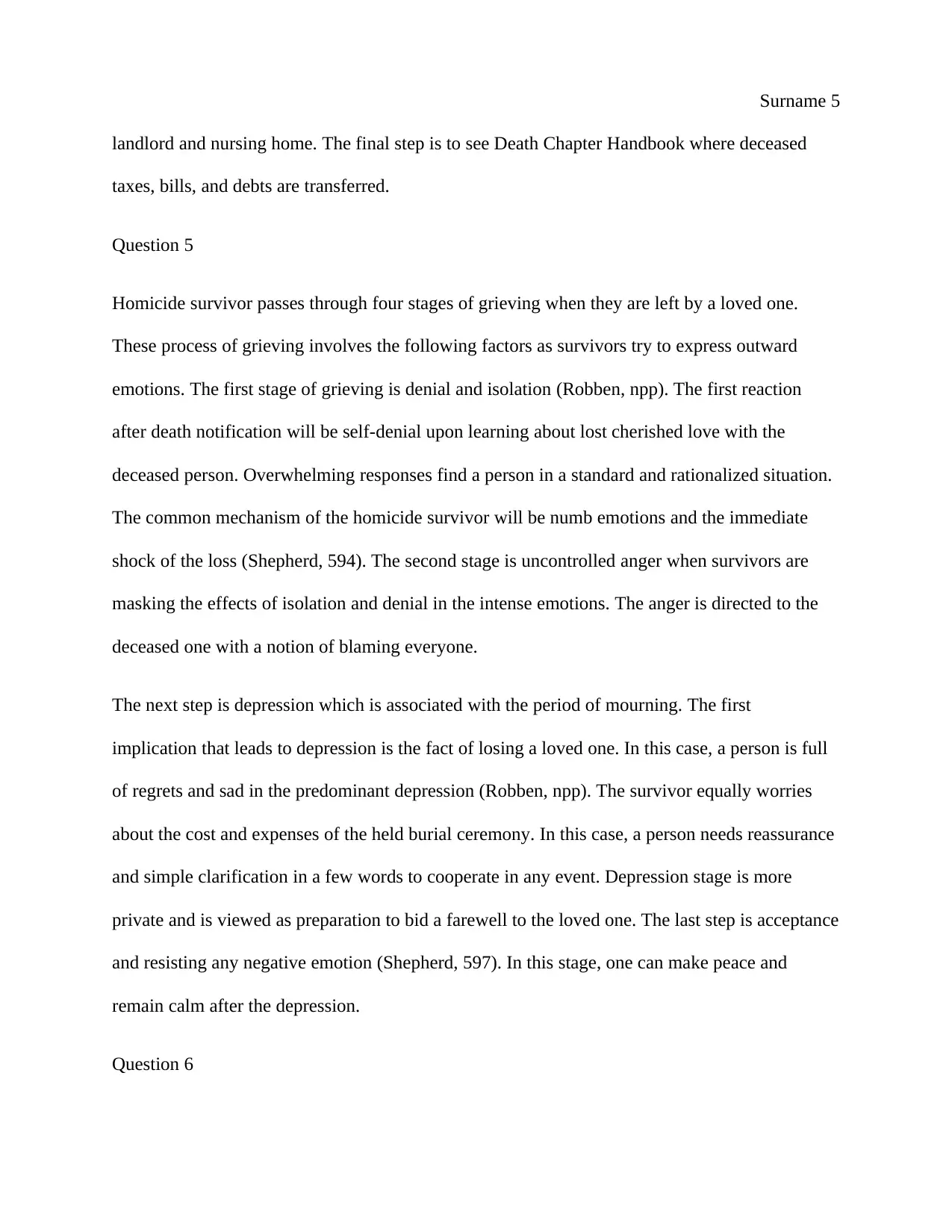
Surname 5
landlord and nursing home. The final step is to see Death Chapter Handbook where deceased
taxes, bills, and debts are transferred.
Question 5
Homicide survivor passes through four stages of grieving when they are left by a loved one.
These process of grieving involves the following factors as survivors try to express outward
emotions. The first stage of grieving is denial and isolation (Robben, npp). The first reaction
after death notification will be self-denial upon learning about lost cherished love with the
deceased person. Overwhelming responses find a person in a standard and rationalized situation.
The common mechanism of the homicide survivor will be numb emotions and the immediate
shock of the loss (Shepherd, 594). The second stage is uncontrolled anger when survivors are
masking the effects of isolation and denial in the intense emotions. The anger is directed to the
deceased one with a notion of blaming everyone.
The next step is depression which is associated with the period of mourning. The first
implication that leads to depression is the fact of losing a loved one. In this case, a person is full
of regrets and sad in the predominant depression (Robben, npp). The survivor equally worries
about the cost and expenses of the held burial ceremony. In this case, a person needs reassurance
and simple clarification in a few words to cooperate in any event. Depression stage is more
private and is viewed as preparation to bid a farewell to the loved one. The last step is acceptance
and resisting any negative emotion (Shepherd, 597). In this stage, one can make peace and
remain calm after the depression.
Question 6
landlord and nursing home. The final step is to see Death Chapter Handbook where deceased
taxes, bills, and debts are transferred.
Question 5
Homicide survivor passes through four stages of grieving when they are left by a loved one.
These process of grieving involves the following factors as survivors try to express outward
emotions. The first stage of grieving is denial and isolation (Robben, npp). The first reaction
after death notification will be self-denial upon learning about lost cherished love with the
deceased person. Overwhelming responses find a person in a standard and rationalized situation.
The common mechanism of the homicide survivor will be numb emotions and the immediate
shock of the loss (Shepherd, 594). The second stage is uncontrolled anger when survivors are
masking the effects of isolation and denial in the intense emotions. The anger is directed to the
deceased one with a notion of blaming everyone.
The next step is depression which is associated with the period of mourning. The first
implication that leads to depression is the fact of losing a loved one. In this case, a person is full
of regrets and sad in the predominant depression (Robben, npp). The survivor equally worries
about the cost and expenses of the held burial ceremony. In this case, a person needs reassurance
and simple clarification in a few words to cooperate in any event. Depression stage is more
private and is viewed as preparation to bid a farewell to the loved one. The last step is acceptance
and resisting any negative emotion (Shepherd, 597). In this stage, one can make peace and
remain calm after the depression.
Question 6
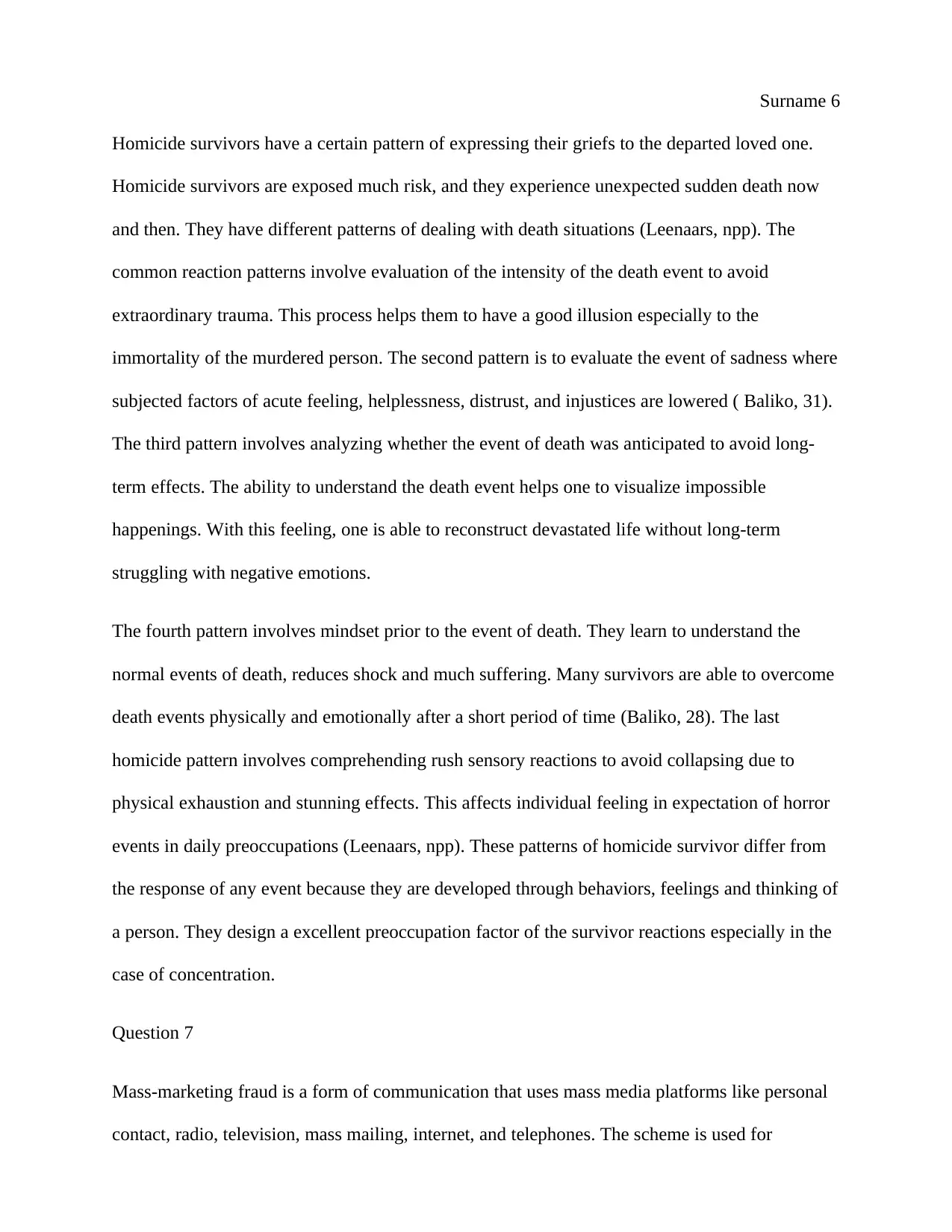
Surname 6
Homicide survivors have a certain pattern of expressing their griefs to the departed loved one.
Homicide survivors are exposed much risk, and they experience unexpected sudden death now
and then. They have different patterns of dealing with death situations (Leenaars, npp). The
common reaction patterns involve evaluation of the intensity of the death event to avoid
extraordinary trauma. This process helps them to have a good illusion especially to the
immortality of the murdered person. The second pattern is to evaluate the event of sadness where
subjected factors of acute feeling, helplessness, distrust, and injustices are lowered ( Baliko, 31).
The third pattern involves analyzing whether the event of death was anticipated to avoid long-
term effects. The ability to understand the death event helps one to visualize impossible
happenings. With this feeling, one is able to reconstruct devastated life without long-term
struggling with negative emotions.
The fourth pattern involves mindset prior to the event of death. They learn to understand the
normal events of death, reduces shock and much suffering. Many survivors are able to overcome
death events physically and emotionally after a short period of time (Baliko, 28). The last
homicide pattern involves comprehending rush sensory reactions to avoid collapsing due to
physical exhaustion and stunning effects. This affects individual feeling in expectation of horror
events in daily preoccupations (Leenaars, npp). These patterns of homicide survivor differ from
the response of any event because they are developed through behaviors, feelings and thinking of
a person. They design a excellent preoccupation factor of the survivor reactions especially in the
case of concentration.
Question 7
Mass-marketing fraud is a form of communication that uses mass media platforms like personal
contact, radio, television, mass mailing, internet, and telephones. The scheme is used for
Homicide survivors have a certain pattern of expressing their griefs to the departed loved one.
Homicide survivors are exposed much risk, and they experience unexpected sudden death now
and then. They have different patterns of dealing with death situations (Leenaars, npp). The
common reaction patterns involve evaluation of the intensity of the death event to avoid
extraordinary trauma. This process helps them to have a good illusion especially to the
immortality of the murdered person. The second pattern is to evaluate the event of sadness where
subjected factors of acute feeling, helplessness, distrust, and injustices are lowered ( Baliko, 31).
The third pattern involves analyzing whether the event of death was anticipated to avoid long-
term effects. The ability to understand the death event helps one to visualize impossible
happenings. With this feeling, one is able to reconstruct devastated life without long-term
struggling with negative emotions.
The fourth pattern involves mindset prior to the event of death. They learn to understand the
normal events of death, reduces shock and much suffering. Many survivors are able to overcome
death events physically and emotionally after a short period of time (Baliko, 28). The last
homicide pattern involves comprehending rush sensory reactions to avoid collapsing due to
physical exhaustion and stunning effects. This affects individual feeling in expectation of horror
events in daily preoccupations (Leenaars, npp). These patterns of homicide survivor differ from
the response of any event because they are developed through behaviors, feelings and thinking of
a person. They design a excellent preoccupation factor of the survivor reactions especially in the
case of concentration.
Question 7
Mass-marketing fraud is a form of communication that uses mass media platforms like personal
contact, radio, television, mass mailing, internet, and telephones. The scheme is used for
⊘ This is a preview!⊘
Do you want full access?
Subscribe today to unlock all pages.

Trusted by 1+ million students worldwide
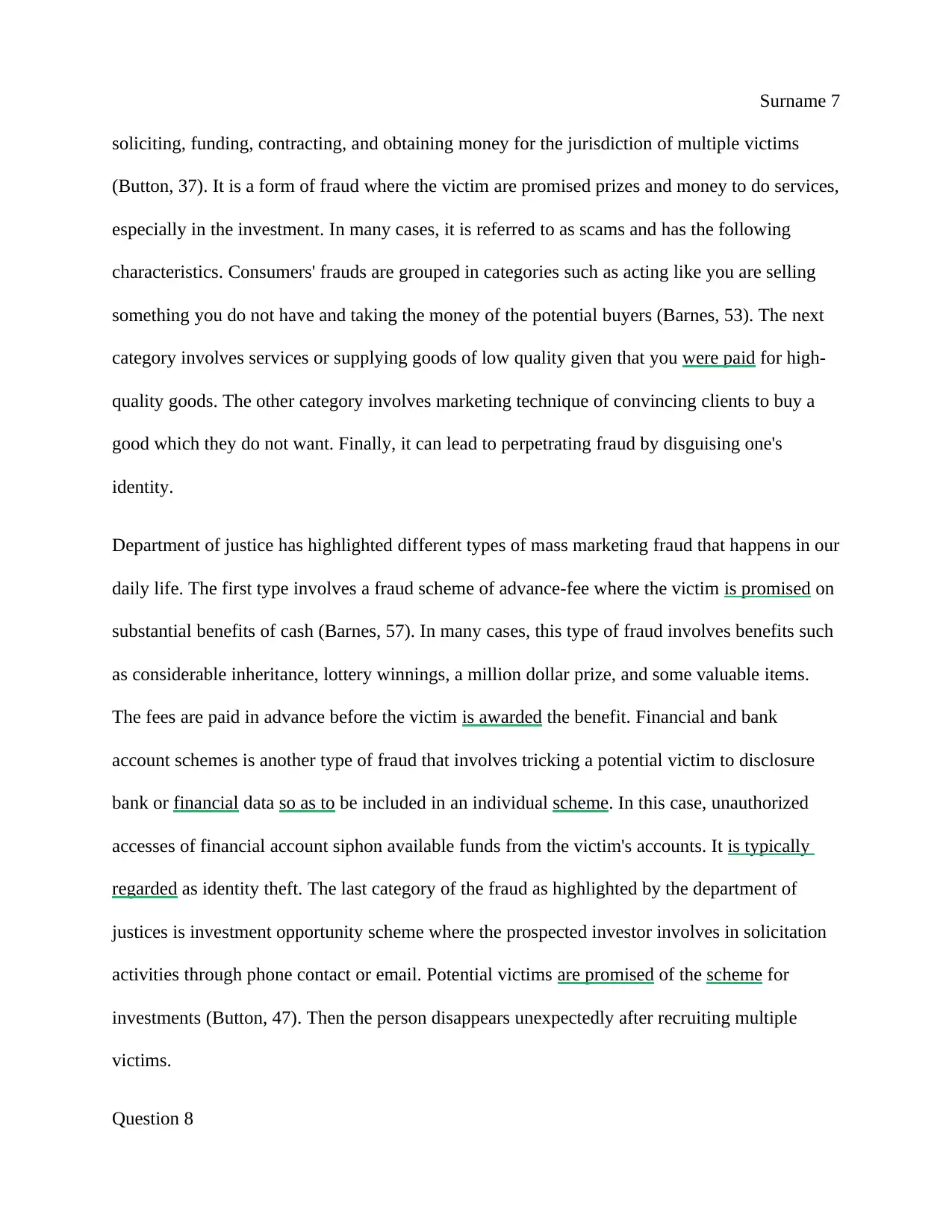
Surname 7
soliciting, funding, contracting, and obtaining money for the jurisdiction of multiple victims
(Button, 37). It is a form of fraud where the victim are promised prizes and money to do services,
especially in the investment. In many cases, it is referred to as scams and has the following
characteristics. Consumers' frauds are grouped in categories such as acting like you are selling
something you do not have and taking the money of the potential buyers (Barnes, 53). The next
category involves services or supplying goods of low quality given that you were paid for high-
quality goods. The other category involves marketing technique of convincing clients to buy a
good which they do not want. Finally, it can lead to perpetrating fraud by disguising one's
identity.
Department of justice has highlighted different types of mass marketing fraud that happens in our
daily life. The first type involves a fraud scheme of advance-fee where the victim is promised on
substantial benefits of cash (Barnes, 57). In many cases, this type of fraud involves benefits such
as considerable inheritance, lottery winnings, a million dollar prize, and some valuable items.
The fees are paid in advance before the victim is awarded the benefit. Financial and bank
account schemes is another type of fraud that involves tricking a potential victim to disclosure
bank or financial data so as to be included in an individual scheme. In this case, unauthorized
accesses of financial account siphon available funds from the victim's accounts. It is typically
regarded as identity theft. The last category of the fraud as highlighted by the department of
justices is investment opportunity scheme where the prospected investor involves in solicitation
activities through phone contact or email. Potential victims are promised of the scheme for
investments (Button, 47). Then the person disappears unexpectedly after recruiting multiple
victims.
Question 8
soliciting, funding, contracting, and obtaining money for the jurisdiction of multiple victims
(Button, 37). It is a form of fraud where the victim are promised prizes and money to do services,
especially in the investment. In many cases, it is referred to as scams and has the following
characteristics. Consumers' frauds are grouped in categories such as acting like you are selling
something you do not have and taking the money of the potential buyers (Barnes, 53). The next
category involves services or supplying goods of low quality given that you were paid for high-
quality goods. The other category involves marketing technique of convincing clients to buy a
good which they do not want. Finally, it can lead to perpetrating fraud by disguising one's
identity.
Department of justice has highlighted different types of mass marketing fraud that happens in our
daily life. The first type involves a fraud scheme of advance-fee where the victim is promised on
substantial benefits of cash (Barnes, 57). In many cases, this type of fraud involves benefits such
as considerable inheritance, lottery winnings, a million dollar prize, and some valuable items.
The fees are paid in advance before the victim is awarded the benefit. Financial and bank
account schemes is another type of fraud that involves tricking a potential victim to disclosure
bank or financial data so as to be included in an individual scheme. In this case, unauthorized
accesses of financial account siphon available funds from the victim's accounts. It is typically
regarded as identity theft. The last category of the fraud as highlighted by the department of
justices is investment opportunity scheme where the prospected investor involves in solicitation
activities through phone contact or email. Potential victims are promised of the scheme for
investments (Button, 47). Then the person disappears unexpectedly after recruiting multiple
victims.
Question 8
Paraphrase This Document
Need a fresh take? Get an instant paraphrase of this document with our AI Paraphraser
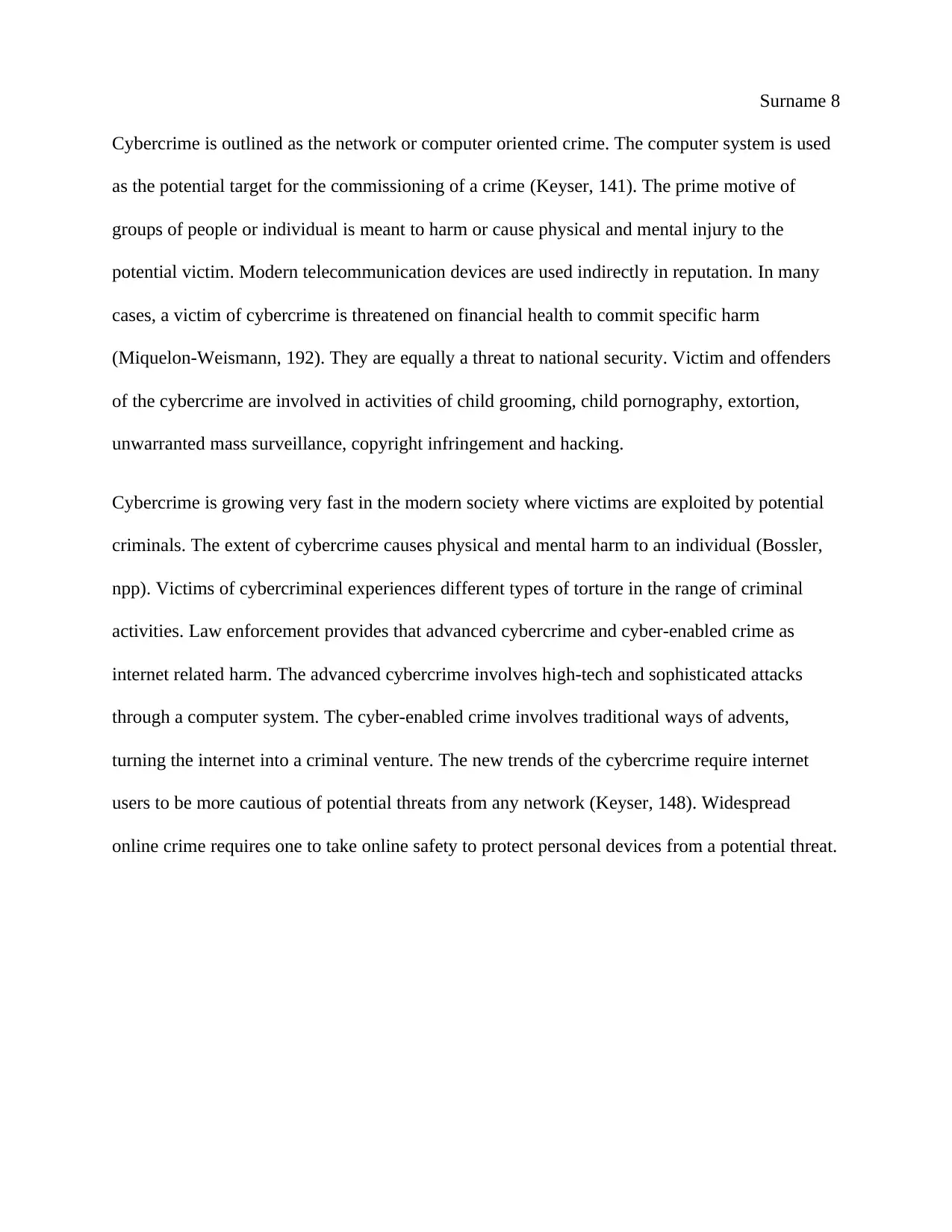
Surname 8
Cybercrime is outlined as the network or computer oriented crime. The computer system is used
as the potential target for the commissioning of a crime (Keyser, 141). The prime motive of
groups of people or individual is meant to harm or cause physical and mental injury to the
potential victim. Modern telecommunication devices are used indirectly in reputation. In many
cases, a victim of cybercrime is threatened on financial health to commit specific harm
(Miquelon-Weismann, 192). They are equally a threat to national security. Victim and offenders
of the cybercrime are involved in activities of child grooming, child pornography, extortion,
unwarranted mass surveillance, copyright infringement and hacking.
Cybercrime is growing very fast in the modern society where victims are exploited by potential
criminals. The extent of cybercrime causes physical and mental harm to an individual (Bossler,
npp). Victims of cybercriminal experiences different types of torture in the range of criminal
activities. Law enforcement provides that advanced cybercrime and cyber-enabled crime as
internet related harm. The advanced cybercrime involves high-tech and sophisticated attacks
through a computer system. The cyber-enabled crime involves traditional ways of advents,
turning the internet into a criminal venture. The new trends of the cybercrime require internet
users to be more cautious of potential threats from any network (Keyser, 148). Widespread
online crime requires one to take online safety to protect personal devices from a potential threat.
Cybercrime is outlined as the network or computer oriented crime. The computer system is used
as the potential target for the commissioning of a crime (Keyser, 141). The prime motive of
groups of people or individual is meant to harm or cause physical and mental injury to the
potential victim. Modern telecommunication devices are used indirectly in reputation. In many
cases, a victim of cybercrime is threatened on financial health to commit specific harm
(Miquelon-Weismann, 192). They are equally a threat to national security. Victim and offenders
of the cybercrime are involved in activities of child grooming, child pornography, extortion,
unwarranted mass surveillance, copyright infringement and hacking.
Cybercrime is growing very fast in the modern society where victims are exploited by potential
criminals. The extent of cybercrime causes physical and mental harm to an individual (Bossler,
npp). Victims of cybercriminal experiences different types of torture in the range of criminal
activities. Law enforcement provides that advanced cybercrime and cyber-enabled crime as
internet related harm. The advanced cybercrime involves high-tech and sophisticated attacks
through a computer system. The cyber-enabled crime involves traditional ways of advents,
turning the internet into a criminal venture. The new trends of the cybercrime require internet
users to be more cautious of potential threats from any network (Keyser, 148). Widespread
online crime requires one to take online safety to protect personal devices from a potential threat.
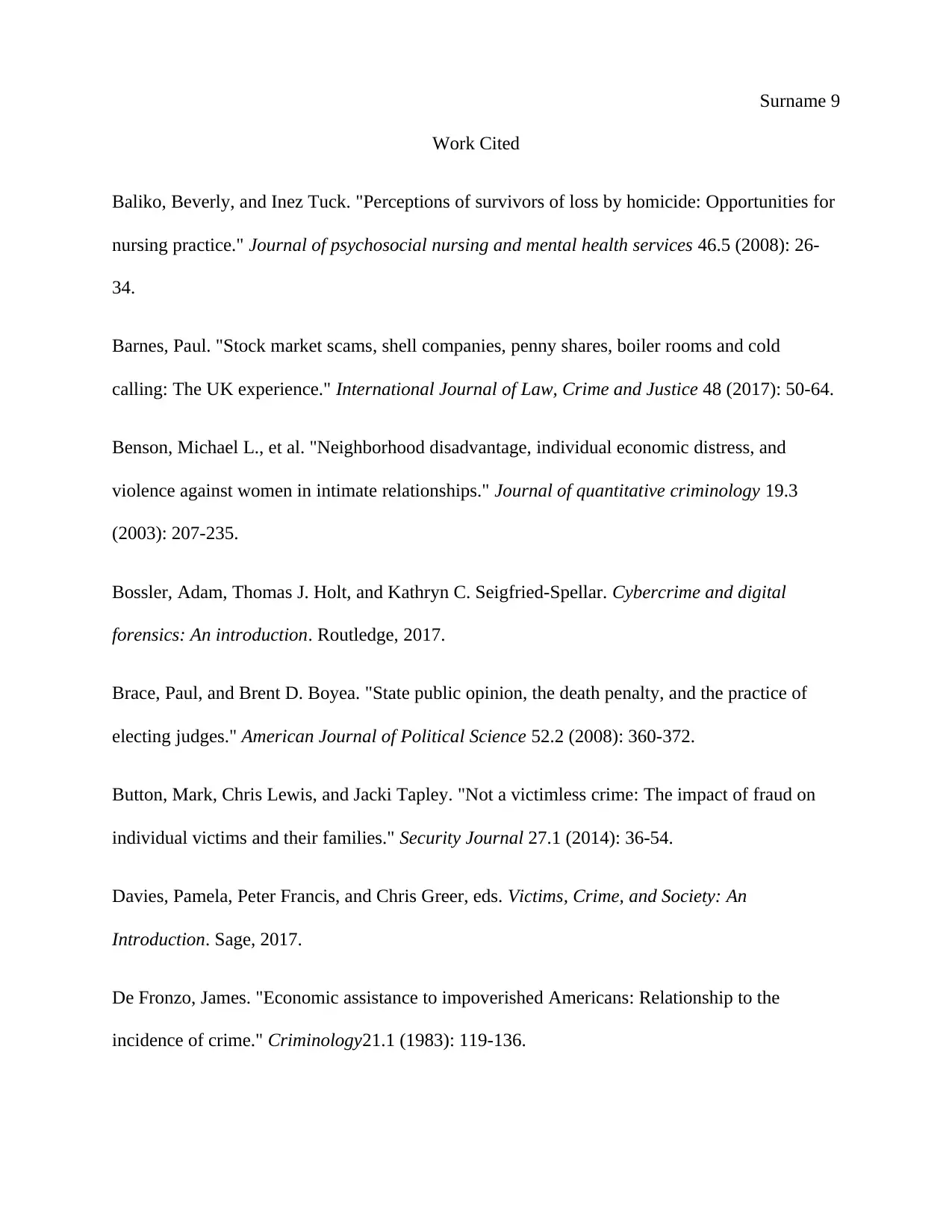
Surname 9
Work Cited
Baliko, Beverly, and Inez Tuck. "Perceptions of survivors of loss by homicide: Opportunities for
nursing practice." Journal of psychosocial nursing and mental health services 46.5 (2008): 26-
34.
Barnes, Paul. "Stock market scams, shell companies, penny shares, boiler rooms and cold
calling: The UK experience." International Journal of Law, Crime and Justice 48 (2017): 50-64.
Benson, Michael L., et al. "Neighborhood disadvantage, individual economic distress, and
violence against women in intimate relationships." Journal of quantitative criminology 19.3
(2003): 207-235.
Bossler, Adam, Thomas J. Holt, and Kathryn C. Seigfried-Spellar. Cybercrime and digital
forensics: An introduction. Routledge, 2017.
Brace, Paul, and Brent D. Boyea. "State public opinion, the death penalty, and the practice of
electing judges." American Journal of Political Science 52.2 (2008): 360-372.
Button, Mark, Chris Lewis, and Jacki Tapley. "Not a victimless crime: The impact of fraud on
individual victims and their families." Security Journal 27.1 (2014): 36-54.
Davies, Pamela, Peter Francis, and Chris Greer, eds. Victims, Crime, and Society: An
Introduction. Sage, 2017.
De Fronzo, James. "Economic assistance to impoverished Americans: Relationship to the
incidence of crime." Criminology21.1 (1983): 119-136.
Work Cited
Baliko, Beverly, and Inez Tuck. "Perceptions of survivors of loss by homicide: Opportunities for
nursing practice." Journal of psychosocial nursing and mental health services 46.5 (2008): 26-
34.
Barnes, Paul. "Stock market scams, shell companies, penny shares, boiler rooms and cold
calling: The UK experience." International Journal of Law, Crime and Justice 48 (2017): 50-64.
Benson, Michael L., et al. "Neighborhood disadvantage, individual economic distress, and
violence against women in intimate relationships." Journal of quantitative criminology 19.3
(2003): 207-235.
Bossler, Adam, Thomas J. Holt, and Kathryn C. Seigfried-Spellar. Cybercrime and digital
forensics: An introduction. Routledge, 2017.
Brace, Paul, and Brent D. Boyea. "State public opinion, the death penalty, and the practice of
electing judges." American Journal of Political Science 52.2 (2008): 360-372.
Button, Mark, Chris Lewis, and Jacki Tapley. "Not a victimless crime: The impact of fraud on
individual victims and their families." Security Journal 27.1 (2014): 36-54.
Davies, Pamela, Peter Francis, and Chris Greer, eds. Victims, Crime, and Society: An
Introduction. Sage, 2017.
De Fronzo, James. "Economic assistance to impoverished Americans: Relationship to the
incidence of crime." Criminology21.1 (1983): 119-136.
⊘ This is a preview!⊘
Do you want full access?
Subscribe today to unlock all pages.

Trusted by 1+ million students worldwide
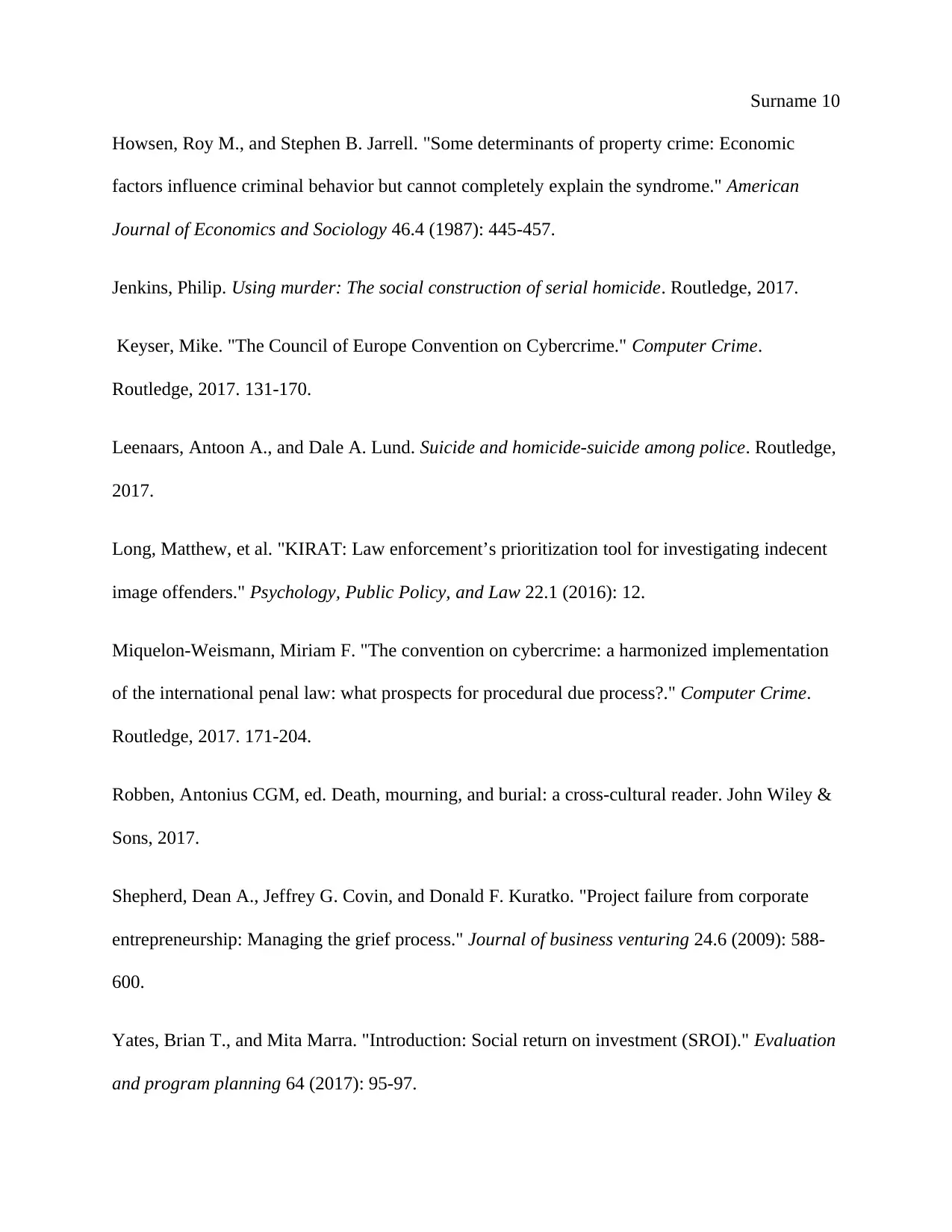
Surname 10
Howsen, Roy M., and Stephen B. Jarrell. "Some determinants of property crime: Economic
factors influence criminal behavior but cannot completely explain the syndrome." American
Journal of Economics and Sociology 46.4 (1987): 445-457.
Jenkins, Philip. Using murder: The social construction of serial homicide. Routledge, 2017.
Keyser, Mike. "The Council of Europe Convention on Cybercrime." Computer Crime.
Routledge, 2017. 131-170.
Leenaars, Antoon A., and Dale A. Lund. Suicide and homicide-suicide among police. Routledge,
2017.
Long, Matthew, et al. "KIRAT: Law enforcement’s prioritization tool for investigating indecent
image offenders." Psychology, Public Policy, and Law 22.1 (2016): 12.
Miquelon-Weismann, Miriam F. "The convention on cybercrime: a harmonized implementation
of the international penal law: what prospects for procedural due process?." Computer Crime.
Routledge, 2017. 171-204.
Robben, Antonius CGM, ed. Death, mourning, and burial: a cross-cultural reader. John Wiley &
Sons, 2017.
Shepherd, Dean A., Jeffrey G. Covin, and Donald F. Kuratko. "Project failure from corporate
entrepreneurship: Managing the grief process." Journal of business venturing 24.6 (2009): 588-
600.
Yates, Brian T., and Mita Marra. "Introduction: Social return on investment (SROI)." Evaluation
and program planning 64 (2017): 95-97.
Howsen, Roy M., and Stephen B. Jarrell. "Some determinants of property crime: Economic
factors influence criminal behavior but cannot completely explain the syndrome." American
Journal of Economics and Sociology 46.4 (1987): 445-457.
Jenkins, Philip. Using murder: The social construction of serial homicide. Routledge, 2017.
Keyser, Mike. "The Council of Europe Convention on Cybercrime." Computer Crime.
Routledge, 2017. 131-170.
Leenaars, Antoon A., and Dale A. Lund. Suicide and homicide-suicide among police. Routledge,
2017.
Long, Matthew, et al. "KIRAT: Law enforcement’s prioritization tool for investigating indecent
image offenders." Psychology, Public Policy, and Law 22.1 (2016): 12.
Miquelon-Weismann, Miriam F. "The convention on cybercrime: a harmonized implementation
of the international penal law: what prospects for procedural due process?." Computer Crime.
Routledge, 2017. 171-204.
Robben, Antonius CGM, ed. Death, mourning, and burial: a cross-cultural reader. John Wiley &
Sons, 2017.
Shepherd, Dean A., Jeffrey G. Covin, and Donald F. Kuratko. "Project failure from corporate
entrepreneurship: Managing the grief process." Journal of business venturing 24.6 (2009): 588-
600.
Yates, Brian T., and Mita Marra. "Introduction: Social return on investment (SROI)." Evaluation
and program planning 64 (2017): 95-97.
Paraphrase This Document
Need a fresh take? Get an instant paraphrase of this document with our AI Paraphraser

Surname 11
Yudkin, Patricia L., et al. "Deaths caused by HIV disease under-reported in South
Africa." Aids 23.12 (2009): 1600-1602.
Yudkin, Patricia L., et al. "Deaths caused by HIV disease under-reported in South
Africa." Aids 23.12 (2009): 1600-1602.
1 out of 11
Related Documents
Your All-in-One AI-Powered Toolkit for Academic Success.
+13062052269
info@desklib.com
Available 24*7 on WhatsApp / Email
![[object Object]](/_next/static/media/star-bottom.7253800d.svg)
Unlock your academic potential
Copyright © 2020–2025 A2Z Services. All Rights Reserved. Developed and managed by ZUCOL.




